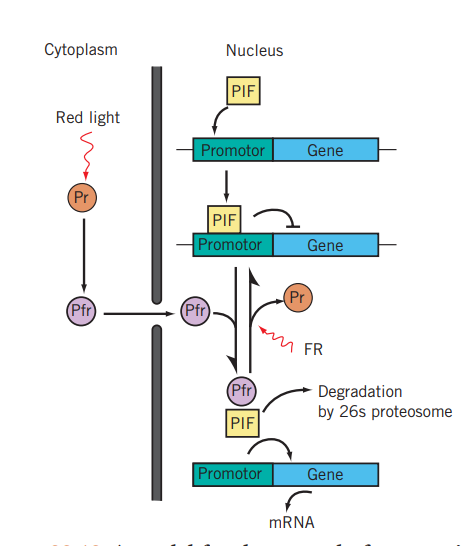The Central Role of Phytochrome in Gene Expression: Illuminating the Pathways of Plant Growth
Phytochromes are pivotal photoreceptor proteins in plants
that act as molecular switches, allowing plants to perceive and respond to
changes in their light environment. The impact of phytochromes extends beyond
mere light sensing; they play a central role in the regulation of gene
expression, orchestrating complex molecular cascades that govern diverse
aspects of plant growth and development. In this detailed article, we will
explore the multifaceted role of phytochrome in gene expression and its significance
in shaping plant responses to light cues.
Phytochrome Structure and Activation:
Phytochromes are typically composed of an apoprotein and a light-absorbing chromophore. The chromophore is covalently linked to the apoprotein and is responsible for absorbing red and far-red light, leading to conformational changes in the protein structure. This light-induced conformational shift is the key to phytochrome activation and marks the transition between the biologically inactive Pr form and the active Pfr form.
Upon exposure to red light, phytochromes convert from Pr to
Pfr, while far-red light triggers the reverse transformation. The dynamic
equilibrium between these two forms serves as a molecular switch that
transduces light signals to the nucleus, initiating a cascade of events that
ultimately affect gene expression.
Phytochrome Localization and Nuclear Translocation:
In the nucleus, Pfr phytochromes interact with specific
transcription factors known as phytochrome-interacting factors (PIFs). This
interaction sets the stage for the intricate regulation of gene expression, as
PIFs are key players in the modulation of transcriptional activity in response
to light stimuli.
Transcriptional Regulation by Phytochromes:
The degradation of PIFs releases their repressive influence
on gene expression, allowing for the activation of light-responsive genes. This
process enables plants to fine-tune their genetic responses to changes in light
conditions, ultimately shaping their growth and development in an adaptive
manner.
Light-Responsive Genes and Physiological Outcomes:
The genes under the control of phytochromes encode a diverse
array of proteins, including those involved in chlorophyll biosynthesis,
photomorphogenesis, seed germination, and flowering. The modulation of gene
expression by phytochromes is a crucial factor in determining the physiological
outcomes of plants in response to light cues.
For instance, during seed germination, phytochromes promote
the expression of genes involved in cell elongation and expansion, enabling the
emergence of seedlings from the soil. In photomorphogenesis, phytochromes
regulate the expression of genes responsible for shaping plant morphology, such
as those involved in leaf expansion and stem elongation.
Conclusion:
The role of phytochrome in gene expression is a fascinating
aspect of plant biology, highlighting the sophisticated mechanisms by which
plants perceive and respond to light. The intricate interplay between
phytochromes, PIFs, and light-responsive genes underscores the adaptability of
plants to their dynamic environments. Understanding these molecular processes
not only deepens our knowledge of plant physiology but also holds potential
applications in agriculture, where manipulating gene expression through light
signaling pathways may enhance crop yield and stress tolerance. As research in
this field progresses, we can anticipate further revelations that will unveil
additional layers of complexity in the regulatory networks controlled by
phytochromes.
Frequently Asked Questions (FAQs) about Phytochromes and Gene Expression in Plants:
1. What are phytochromes? Phytochromes are
light-sensitive proteins found in plants, crucial for their ability to sense
and respond to changes in their light environment. They play a vital role in
regulating various aspects of plant growth and development.
2. How do phytochromes influence gene expression?
Phytochromes influence gene expression by undergoing conformational changes in
response to red and far-red light. The activated form (Pfr) translocates to the
nucleus, where it interacts with transcription factors called
phytochrome-interacting factors (PIFs), ultimately regulating the expression of
target genes.
3. What is the significance of the Pr and Pfr forms of
phytochromes? The Pr (inactive) and Pfr (active) forms represent the two
states of phytochromes. Red light converts Pr to Pfr, while far-red light
triggers the reverse transition. This dynamic equilibrium allows phytochromes
to function as molecular switches, relaying information about light conditions
to the plant.
4. How do phytochromes affect seed germination? Phytochromes
promote seed germination by influencing the expression of genes involved in
cell expansion and growth. The activation of specific genes facilitates the
emergence of seedlings from the soil.
5. What is the role of phytochromes in
photomorphogenesis? Phytochromes play a key role in photomorphogenesis,
influencing genes responsible for leaf expansion, stem elongation, and overall
plant morphology. This process ensures that plants adapt their growth patterns
to optimize light capture.
6. Do phytochromes only respond to red light?
Phytochromes predominantly respond to red light, leading to their activation
from the Pr to Pfr form. However, they also sense far-red light, triggering the
reverse transition. This dual responsiveness allows plants to perceive
different aspects of their light environment.
7. How do phytochromes contribute to flowering?
Phytochromes influence the timing of flowering by regulating the expression of
genes involved in the transition from vegetative to reproductive phases. The
interaction between phytochromes and other environmental cues ensures that
plants flower under optimal conditions.
8. Can phytochromes be manipulated for agricultural
purposes? Research is ongoing to understand how phytochromes can be
manipulated to enhance agricultural practices. By influencing gene expression,
phytochromes may offer opportunities to optimize crop yield, stress tolerance,
and other desirable traits.
9. Are phytochromes the only photoreceptors in plants?
No, phytochromes are just one group of photoreceptors. Plants also have other
photoreceptors, such as cryptochromes and phototropins, which contribute to
light perception and signaling. These photoreceptors often interact to form a
complex network of light-responsive pathways.
10. How does the duration and intensity of light affect
phytochrome-mediated responses? The duration and intensity of light
exposure play a crucial role in determining which genes are activated or
repressed by phytochromes. Different light conditions can trigger specific
responses, allowing plants to adapt to their environment in a nuanced manner.








.jpg)
0 Comments